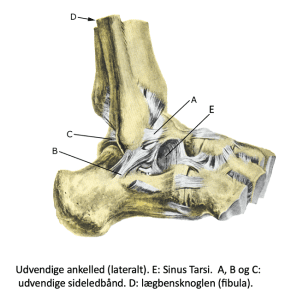Anatomy
The sinus tarsi is a funnel-shaped cavity on the outside of the foot in front of the ankle bone (lateral malleolus) between the heel bone (calcaneus) and the ankle roll bone (talus). The sinus tarsi contains fat, blood vessels, nerves and ligaments. The ligaments help stabilise the joints and maintain the longitudinal arch of the foot.
Cause of the problem
The cause of the pain cannot always be identified (Madeleine Willegger et al 2023), but is often seen after twisting the ankle (suppination trauma) resulting in ligament damage. Flat feet predispose to sinus tarsi syndrome.
Symptoms
Diffuse deep, burning or shooting pain externally (laterally) and centrally in the ankle and foot with aggravation on exertion especially on uneven/soft ground such as running on grass and in some cases just prolonged standing. The pain often improves after warming up. Looseness of the ankle is often felt.
Examination
The diagnosis is usually made on clinical examination by a relevant professional, with pressure tenderness in front of the outer ankle bone similar to sinus tarsi with aggravation on twisting the ankle joint. MRI scans can detect cartilage and bone damage (Khan I, et al. 2023), while ultrasound scans can detect inflammation and fluid.
If there is any doubt about the diagnosis, a local anaesthetic can be injected into the sinus tarsi under ultrasound guidance, which will eliminate symptoms for about 1 hour if the diagnosis is correct (diagnostic blockade).
Treatment
Treatment primarily includes relief from pain-inducing activities (running) and slowly increasing rehabilitation within the pain threshold. Possible correction of incorrect foot position (pronation). If there is no steady progress on relief and rehabilitation, treatment can be supplemented with medical treatment in the form of arthritis pills (NSAIDs) or ultrasound-guided injection of adrenal cortex hormone into the sinus tarsi (Toy S, et al. 2023).
For long-term discomfort with insufficient relief, rehabilitation and medical treatment, surgery to clean up the sinus tarsi can be attempted, but there is little evidence of the effect of surgery.
Complications
If no progress is made, consider whether the diagnosis is correct or if complications have arisen.
In particular, the following should be considered:

